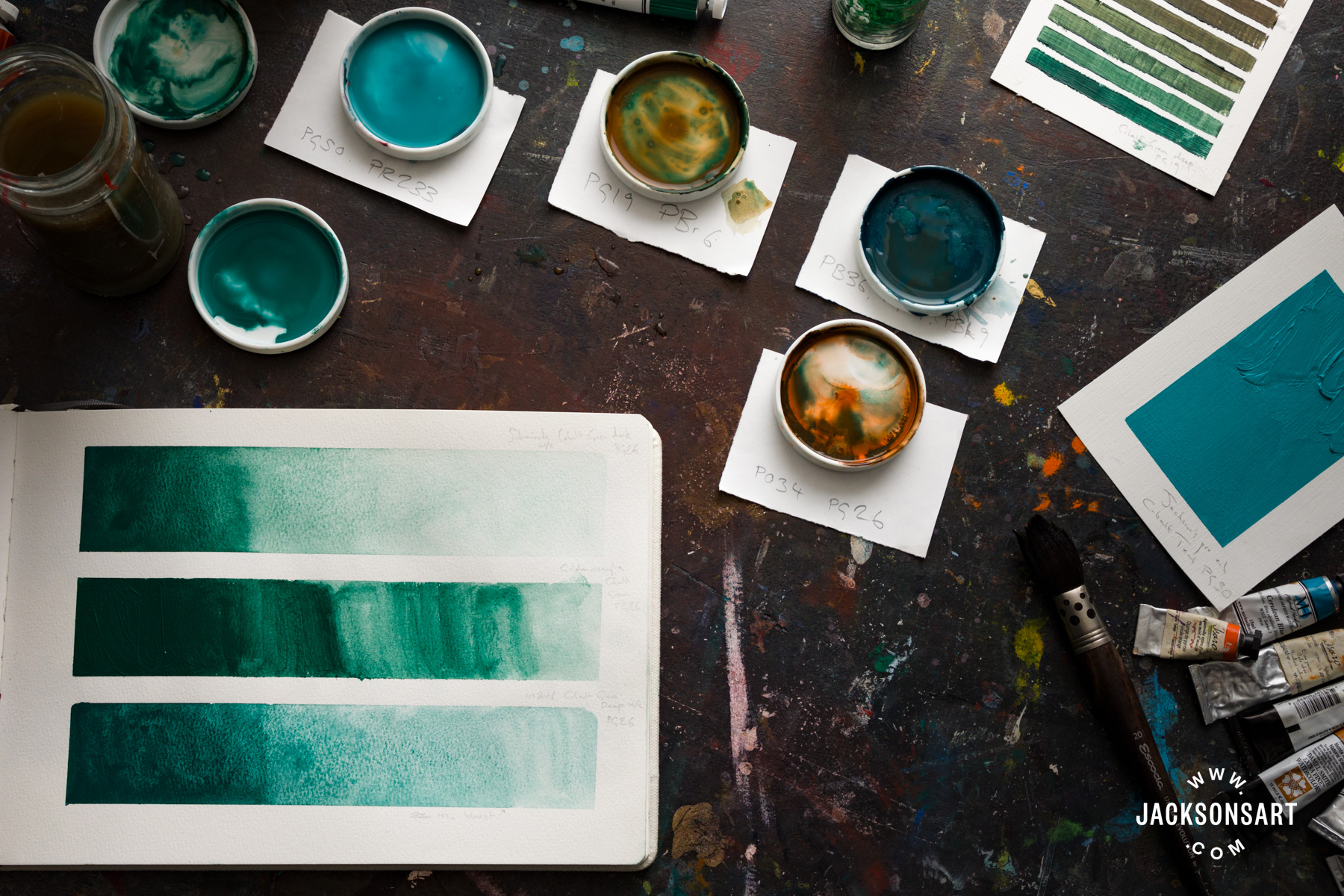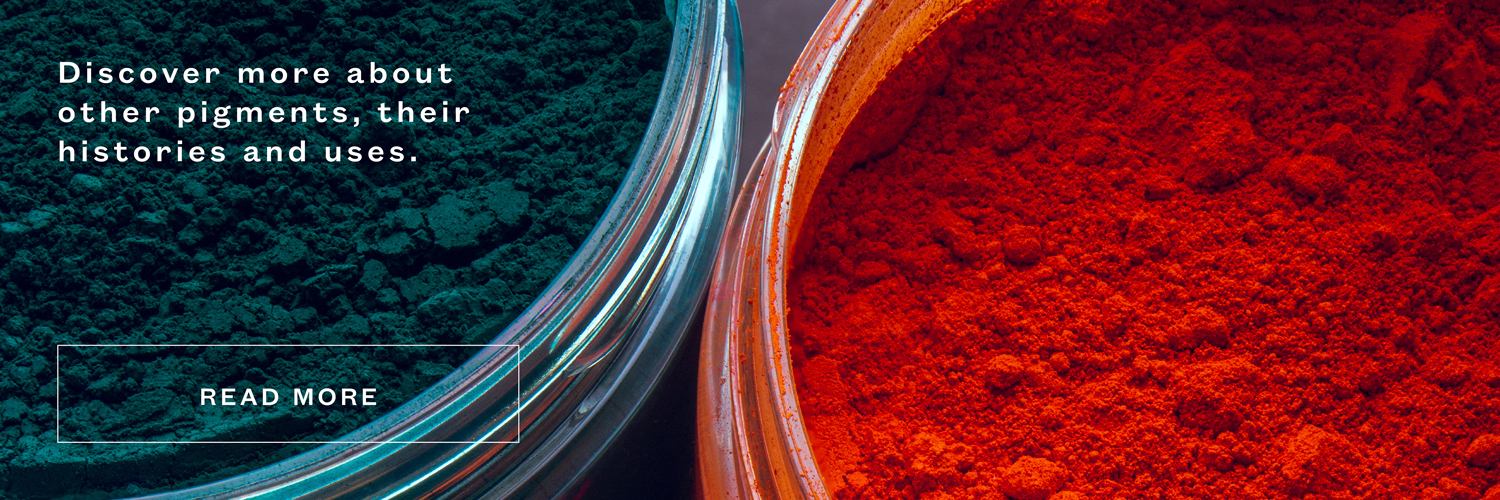
Cobalt Green was first introduced as an artist pigment at the beginning of the 19th century. However, it was not very popular among artists at the time, and it often continues to be overlooked in favour of brighter and less expensive green pigments. This article examines the three Cobalt Green pigments in use today and explores the unique characteristics they bring to modern artists’ palettes.
Cobalt Green: The Pigment Overlooked by the Impressionists
The History of Cobalt Green
The first Cobalt Green pigment, a compound of zinc and cobalt oxides, was formulated in 1780 by Swedish chemist Sven Rinman. However, zinc oxide was being manufactured on a small scale at the time, so the pigment wasn’t introduced in commercial artists’ paints until the 1830s. As far as chemical stability was concerned, Cobalt Green ticked every box: It was extremely lightfast and permanent and suitable for both oil and water-based binding mediums. These characteristics were extremely valuable at a time when new pigments were being developed and introduced very quickly, many of them chemically unreliable.
However, Cobalt Green didn’t capture the imagination of many artists. It was very expensive, gritty, dull, lacking in tinting power, and was described by 19th-century purveyor of pigments George Field as ‘chemically good, but artistically bad.’ It probably didn’t help that Cobalt Green had to compete with two other pigments introduced at around the same time; the inexpensive and vibrant Emerald Green and the jewel-like Viridian. Both of these pigments were used extensively by painters working in the late 19th century, including the Impressionists and Post-Impressionists. However, Cobalt Green rarely appears in pigment analysis of paintings from the time. One exception was French painter Éduoard Vuillard (1868-1940), who is known to have used the pigment.

Repast in a Garden, 1898
Edouard Vuillard
Oil on cardboard, 54.3 x 53.1 cm | 21 3/8 x 20 7/8 in
National Gallery of Art
While it may not have enjoyed much artistic success, Cobalt Green has more recently been recognised in other fields. In the last two decades, research has identified the pigment’s potential in computer technology. Cobalt Green can be magnetised at room temperature and could be used in the creation of extremely fast, energy-efficient computers that otherwise only function at sub-zero temperatures. It’s a fascinating reminder that the uses of pigments extend beyond the artist palette.
Cobalt Green Today
Despite the fact that Cobalt Green has never been a widely popular artist pigment, it is still used in professional artist paint ranges today. There are three green cobalt pigments currently in use. They cover a spectrum of shades, but primarily offer cool blue-greens.
Paints made with the pigment PG19 (zinc-cobalt oxide) use the original pigment invented in the late 18th century. It would be very interesting to compare a sample of the original pigment with the modern versions below. Comparing it with George Field’s description of it, which lamented its weak colour-strength, it seems that it has improved considerably.
Among these paints made with PG19 there is quite a variation in hue. Michael Harding’s Cobalt Green Deep oil paint has a particularly strong blue bias, while Schmincke’s Cobalt Green Pure watercolour is much more yellow. It doesn’t seem possible that these are made with the same pigment, but pigments can vary considerably depending on how they have been manufactured, even if they contain the same chemical constituents.
Both Michael Harding and Schmincke’s paints are very opaque, but Daniel Smith’s Cobalt Green Pale is much more transparent and much lower in tinting strength. It has a slightly ‘gummy’ quality that makes it a little uncooperative in the palette and on the page. While it isn’t the easiest colour to use, it is beautifully textural and granulating.
Another Cobalt Green pigment in use today is PG26, a mixture of oxides of cobalt and chromium. It is difficult to find out exactly when this pigment was first produced, but it is not mentioned in Chromatography, George Field’s extensive treatise on artist pigments published in 1835, so it seems that it was a later introduction.
With PG26, there appears to be more consistency across different paints. All three versions tested here are deep, opaque blue-greens, perhaps best described as sea green. They are all very textural, with the watercolours granulating heavily.
The third Cobalt Green pigment used by artists today might in some case be more accurately called a blue pigment, but it is categorised in the Pigment Colour Index as green. It is PG50, a cobalt titanate pigment.
Like with PG26, it is not clear exactly when PG50 was invented or introduced, but its position in the Pigment Colour Index suggests that it is a 20th-century addition. While it can produce a range of different green hues (like the leaf-green above), PG50 is most often a bright, cool teal. PG50 is extremely dense and opaque, it generally has a higher tinting strength than the other Cobalt Green pigments, and is granulating in watercolour.
It’s safe to say that the complaints that 19th-century artists had about Cobalt Green’s colour strength do not apply today. Most of the examples above are rich and strong, with moderate to high tinting strength. They are all opaque (with the exception of Daniel Smith’s Cobalt Green Pale, which is extremely transparent).
Colour Mixing with Cobalt Green
The first two Cobalt Green pigments, PG19 and PG26, are rarely suggested as standard mixing colours. This is probably because they are very expensive and there are many other pigments, like Phthalo or Chromium Oxide Green, that provide much better value for money. However, there are certain characteristics that Cobalt Greens provide which can make them valuable additions to the artist palette.
Cobalt Greens make interesting mixing partners with warm reds. Below, Michael Harding’s Cobalt Green Deep (PG19) and Jackson’s Cobalt Teal (PG50) have been mixed with Pyrrole Red (PR254) and Transparent Oxide Red (PR101). Both reds are much higher in tinting strength than Cobalt Green, so care needs to be taken to not be too heavy-handed, but together they make some beautifully shadowy dark values that have an enigmatic purple undertone.
Earth colours, like Sienna, Umber, and Ochre, make very satisfying mixing partners with Cobalt Greens. They have a very similar density and granular texture, which makes for some harmonious mixtures. Cobalt Green pigments on their own tend to be rather unnatural greens, not the kinds found in the natural landscape. But with earth pigments, they produce a spectrum of effortlessly mossy greens. In watercolour these greens granulate, adding another dimension of texture that could really elevate a landscape painting.
The textural possibilities of Cobalt Green pigments are perhaps their greatest strength in a watercolour palette. When you mix a Cobalt Green watercolour with other highly granulating colours, and add plenty of water, you can create some astonishing textural washes. The following mixtures were inspired by Schmincke’s Horadam Supergranulation Watercolour range, many of which contain Cobalt Green pigments.

A mixture of Michael Harding Sunset Orange watercolour (PO34) and Winsor & Newton Cobalt Green Deep Professional watercolour (PG26)

Michael Harding Sunset Orange watercolour (PO34) and Winsor & Newton Cobalt Green Deep Professional watercolour (PG26)
Cobalt Green pigments may not work for all artists. They don’t always represent the best value for money or the brightest colour pay-off, but they are certainly full of character. Particularly in watercolour, the granulating capacity of Cobalt Green pigments is something of a superpower, and a watercolourist who likes to build texture in their work would enjoy giving them a try.
Further Reading
Pigment Colour Index: Green Pigments
Recreating Van Gogh’s Colour Palette with Modern Pigments
Chromatic Black: Mixing Nuanced Dark Values
Pigment Stories: Viridian Green
Shop Cobalt Green on jacksonsart.com













